In 1973, South Africa’s largest and most complex civil engineering project undertaken to date was officially opened. In recognition of the 50th anniversary of the momentous occasion of the opening of the Gariep Dam, the South African Institution of Civil Engineering (SAICE) has published the story of the Orange River Project entitled: Water for a Thirsty Land.
The book is a product of many contributions of SAICE colleagues and individuals who worked on the dam and tunnel construction, as well as contributions from those who have benefited from the Orange River project explained Tony Murray, a committee member of SAICE’s History and Heritage Panel. “The decision to chronicle the Orange River project and the construction of the Gariep Dam came in 2019, in order to highlight the importance of the project to the country to coincide with the 50th anniversary of the dam’s completion.” Murray explained that the construction of the Gariep Dam represented such a significant milestone in the history of South Africa, not just as it still stands as the largest civil engineering project yet undertaken, but the downstream social and economic benefits are quite staggering and often overlooked and taken for granted. Professor in Transport Planning and Engineering, at the University of Cape Town and 2022 SAICE President Marianne Vanderschuren, said that at the time, as with many large civil engineering projects, the Orange River Project has had its fair share of opposition and controversy. Without trying to devalue arguments against the project, or dams in general, she said: “It is important to acknowledge the benefits generated by the Vanderkloof and Gariep dams over the past fifty years.” She added that the water source has been a provider of life in the form of food and drinking water, and a catalyst for the generation of employment for thousands in all walks of life.“Improved food production has promoted food security and provided additional economic benefits through the growth of export markets. There are even some economic benefits created by tourism and recreational activities at the sites.
“More importantly, in a time where the use of renewable energy is paramount, due to the negative impacts of coal-based electricity on the local and global environment, the engineering foresight needs to be commended,” explained Vanderschuren. A single project that added to institutional capacity Finally approved in 1962, the aim of building the Vanderkloof and Gariep dams was to provide irrigation to vast areas of dry land, the control of floods and the provision of hydro-electric power. In today’s South Africa, the Orange River dam must carefully balance the supply of water resources for irrigation, potable water and electricity generation. Murray adds: “The engineering knowledge gained during the design, implementation and operation of the Orange River Project has benefitted generations of young engineering students and graduates, South African classrooms, and engineering firms both locally and abroad”. Vanderschuren concludes: “The authors have done the profession and the country a great service by recording the history of this project and reminding us how bold and imaginative ideas, decisions and actions can bring new benefits and wealth through the medium of civil engineering. But they also show a glimpse of the great variety of work and expertise that is inherent in the profession, and the feeling of satisfaction and pride in leaving these benefits for humanity. I trust a great many readers will enjoy their efforts.”






